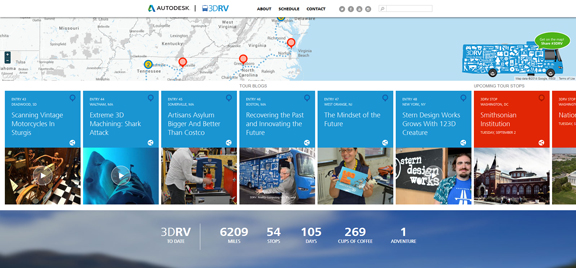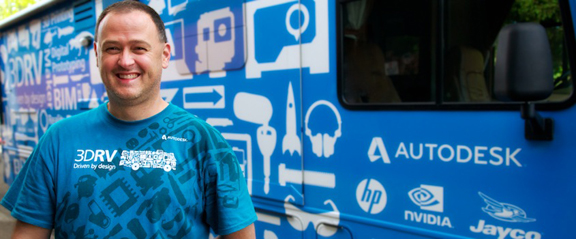Latest News
August 28, 2014
A blue RV painted with and gadgets and branded with high-tech logos is making its way across the U.S., from California to the New York Islands. The vehicle is commandeered by TJ McCue, a writer and 3D enthusiast. The road trip’s goal is to “[celebrate] the creative process, while illuminating the impact of design through firsthand customer stories, consumer creativity and student innovations,” as TJ puts it in his blog.
The 3DRV, as the journey is called, will cover more than 100 stops in eight months. The road trip is made possible by Autodesk, NVIDIA, HP, and Stratasys, among others. So far, TJ has met with people developing a 3D printer that’ll work in space, an underwater camera that could survive shark bites, and footwear that could double as a cellphone charger. As of today, the RV has covered 6,209 miles, made 54 stops, and TJ has gulped down his 269th cup of coffee.
TJ took some time out from his driving and sightseeing to respond to my questions. So here’s a Q&A with TJ, made possible by WiFi.
DE: How has engineers’ working habits changed? For example, are the people you meet working from mobile devices instead of desktops?
TJ: I’d say it is a mix, for sure, with most still on desktops. There are some artisan/craftsman/maker types who are using Autodesk 123D apps on the iPad for creating products. And there are engineering firms, AEC (architecture/construction/engineering) firms, using the iPad as a scanner or using it to pull up a drawing when out in the field. I wouldn’t say it’s 50/50, but mobile is growing dramatically.
DE: Does regional culture or economy affects people’s access to technology?
TJ: I haven’t found this to be true—maybe metro vs. rural is something where we’d see regional culture’s impact. But, in my experience, it is a mindset and you are either a tech adopter or you’re not. If you’re a heavy tech user, it doesn’t matter where you are located. On the economy part, I’m not really qualified to comment, but I’ve seen some very positive things where public libraries create maker spaces or Arduino classes to help give access to those who don’t have any or limited access. To be fair, that’s a slow, much too slow, process.
DE: Do you hear common complaints, praises, or technology wish-lists from the people you’re visiting?
TJ: Mostly, I find people wanting more tech, that’s for sure. They see the Stratasys Mojo printer or the Faro Focus laser scanner or the DotProduct scanner or the Drone and they want one, for sure. They can see the uses for different 3D tech in their workflows. I often let them know there are service bureaus and rental shops that can help them get a project done without purchasing. That is an area where people are often unaware—that you don’t have to buy. In various maker communities, people will hack something together and make it work vs. buying an expensive piece of equipment. Or share one if they have it.
DE: Do you notice a shared concern or a pattern among the inventors and tinkerers you visited? For example, do they show the same concern for environmental issues? Do most of them rely on crowd-sourced funding to fuel their projects?
TJ: I don’t hear much about environmental issues. I do hear people say that additive is way better than subtractive, for the environment. As for funding—that’s a mix too. To do a crowd-funding campaign takes a certain personality and many of the people I’m meeting are introverted, so it will take a lot for them to move something on Kickstarter. However, I have met several people for whom that is not a concern, and they have run successful crowd-funding campaigns. A guy in Chicago, Ray Doeksen, launched a new, super cool metal chair via Kickstarter, and some guys in Providence, Rhode Island, made the Modio toy system. More generally, in other conversations I’ve had about crowd-funding with makers and entrepreneurs, most are super excited at the potential of the platforms. The potential to put the little guys on the same level with the big guys, or at least to make it more equitable, more open, more balanced, I personally believe, has opened the door to whole new era of invention and inventiveness.
This week, TJ is visiting the Fort McHenry National Monument, the site of a battle that inspired Francis Scott Key’s lyrics to “The Star-Spangled Banner.” Will TJ get to fly a drone around the fort’s ground? TJ hasn’t blogged about this stop yet, so the answer is still up in the air, so to speak.
Subscribe to our FREE magazine, FREE email newsletters or both!
Latest News
About the Author
Kenneth Wong is Digital Engineering’s resident blogger and senior editor. Email him at [email protected] or share your thoughts on this article at digitaleng.news/facebook.
Follow DE







